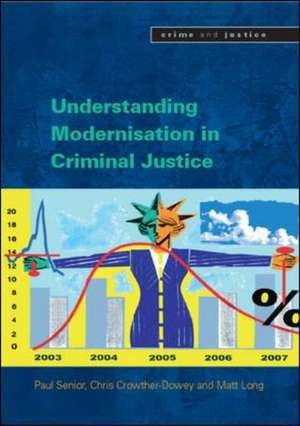Understanding Modernisation in Criminal Justice
Autor Paul Senior, Chris Crowther-Dowey, Matt Longen Limba Engleză Paperback – 15 dec 2007
- How have different criminal justice agencies responded to the modernization process?
- What forms does modernization take?
- What lessons can be drawn to influence the future shape of criminal justice policy?
The book concludes with a look ahead, anticipating developments in criminal justice sector after the departure of Tony Blair and potentially post a new Labour administration.
Understanding Modernization in Criminal Justiceis invaluable reading for those concerned with the administration of criminal justice at both a policy and managerial level; from students and academics wishing to understand the way agencies are responding to this agenda through to penal reformers and commentators.
Preț: 363.74 lei
Nou
Puncte Express: 546
Preț estimativ în valută:
69.60€ • 72.82$ • 57.82£
69.60€ • 72.82$ • 57.82£
Carte tipărită la comandă
Livrare economică 03-17 aprilie
Preluare comenzi: 021 569.72.76
Specificații
ISBN-13: 9780335220656
ISBN-10: 0335220657
Pagini: 280
Dimensiuni: 173 x 243 x 20 mm
Greutate: 0.52 kg
Editura: McGraw Hill Education
Colecția Open University Press
Locul publicării:United Kingdom
ISBN-10: 0335220657
Pagini: 280
Dimensiuni: 173 x 243 x 20 mm
Greutate: 0.52 kg
Editura: McGraw Hill Education
Colecția Open University Press
Locul publicării:United Kingdom
Cuprins
Series
editor's
foreword
List of acronyms Introduction
Part One
1 Understanding the concept of modernisation
2 From welfare to new public managerialism: 1945-97
3 Understanding the modernisation policy process
Part Two
4 Modernisation and youth justice
5 Modernisation and the correctional services
6 Modernisation and community safety
7 Modernisation and the court system
8 Modernisation and the police
9 Modernisation and the voluntary and community sector
Part Three
10 Conclusions and way forward
References
Index
List of acronyms Introduction
Part One
1 Understanding the concept of modernisation
2 From welfare to new public managerialism: 1945-97
3 Understanding the modernisation policy process
Part Two
4 Modernisation and youth justice
5 Modernisation and the correctional services
6 Modernisation and community safety
7 Modernisation and the court system
8 Modernisation and the police
9 Modernisation and the voluntary and community sector
Part Three
10 Conclusions and way forward
References
Index








